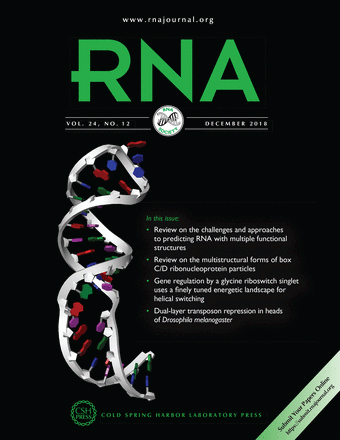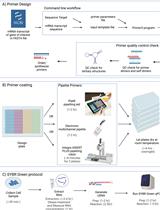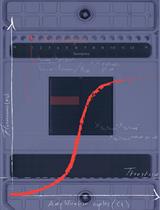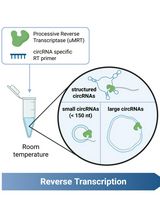- EN - English
- CN - 中文
Northern Blot with IR Fluorescent Probes: Strategies for Probe Preparation
利用多种标记方法进行IR标记探针的Northern杂交
发布: 2019年04月20日第9卷第8期 DOI: 10.21769/BioProtoc.3219 浏览次数: 11308
评审: Gal HaimovichPabitra Kumar SahooSwati MeghaAnca Savulescu
Abstract
Northern blot is a molecular biology technique that can detect, quantify, and determine the molecular weight of RNA. Recently, we published a protocol utilizing near-infrared (IR) fluorescent probes in Northern blot (irNorthern). Our method is as sensitive as other non-radioactive methods but is more straightforward and versatile. Additionally, we found that IR-labeled probes can be used to multiplex or detect different species of RNA at the same time. Here we describe three methods for generating an IR-labeled probe as well as how to perform irNorthern blot. In conclusion, our irNorthern protocol offers a convenient method for RNA detection.
Keywords: Northern blot (Northern杂交)Background
Northern blot analysis is one of the foundational techniques available to biochemists and molecular biologists. While newer and more high-throughput techniques have been adopted, the Northern blot remains a powerful and adaptable method of analyzing RNA size and quantity simultaneously. In brief, DNA or RNA oligonucleotides labeled with radioactive phosphorus-32 (32P) are hybridized to a membrane crosslinked with RNA and subsequently detected using autoradiography (Alwine et al., 1977). Nonetheless, the use of 32P is subject to institutional regulation, and safety precautions must be observed during its use (Jones, 2005). Additionally, 32P probes have short lifespans increasing their cost for use. Alternative protocols using digoxigenin (DIG) conjugated to dNTP or NTP have been developed to replace 32P (Seibl et al., 1990). While successful, DIG probes require secondary detection by antibodies, more hands-on time and expensive reagents, deterring its wider adoption. Our recently published method, irNorthern, is straightforward and adaptable. It utilizes IR dyes which reduce auto-fluorescent background (Zarnegar et al., 2016; Miller et al., 2018). These IR dyes are conjugated with a dibenzocyclooctyne group (DBCO), which forms a covalent bond with the azide on the probes through copper-free click chemistry. To demonstrate its applications, we performed irNorthern to detect microRNA let-7a and small nuclear RNA U6 in total RNAs extracted from HCT116 wild-type and Drosha knockout cells (Kim et al., 2016). In addition, we provide details on how to generate three different azide-containing DNA or RNA probes for IR-dye labeling: a chemically synthesized DNA probe with an internal azide modification on dT, a DNA probe labeled with azide-dU by terminal transferase (TdT), and an RNA probe labeled with azide-U by T7 RNA polymerase.
Materials and Reagents
- Seal-Rite 1.5 ml microcentrifuge tube (USA Scientific, catalog number: 1615-5599)
- Hybridization tube (Fisher Scientific, catalog number: 13-247-300)
- Hybond N+ 30 cm x 3 M Roll (GE, catalog number: RPN303B)
- 50 ml centrifuge tubes (Genesee, catalog number: 21-106)
- 15 ml centrifuge tubes (Genesee, catalog number: 21-101)
- 1,250 µl pipet tips (USA Scientific, catalog number: 1112-1720)
- 0.1-10/20 µl pipet tips (USA Scientific, catalog number: 1110-3700)
- 200 µl pipet tips (USA Scientific, catalog number: 1110-1700)
- Whatman Grade 3 MM Chr blotting paper, sheet, 46 x 57 cm (GE, catalog number: 3030-917)
- 6-Well cell culture plates (Genesee Scientific, catalog number: 25-105)
- Paper towels (Highmark, catalog number 4497A1)
- Glass tray (Pyrex, catalog number: 1124847)
- Aluminum foil roll (Fisher, catalog number: 01-213-102)
- Sheet protectors (Office Depot, catalog number: 491694)
- HCT116 Parental cell line (Korean Collection for Type Cultures, catalog number: BP1230983)
- HCT116 Drosha KO #40 cell line (Korean Collection for Type Cultures, catalog number: BP1230984)
- let-7a irNorthern probe (5′-AACTATACAACCTACTACCTCA/iAzideN/A-3′)
Notes:- Probes are ordered from Integrated DNA Technology at 100 nmole scale, with one internal azide, and purified by HPLC.
- DNA probes are designed to be complementary to the target RNA. For miRNA targets, the probe is the full length (~22 nts) reverse complement of the mature miRNA. An internal azide is added close to the 3′ end with a terminal nucleotide as required for the synthesis.
- U6 irNorthern probe (5′-GCAGGGGCCATGCTAATCTTCTCTGTATCG/iAzideN/T-3′)
Note: Probe sequences for commonly used target RNAs can be found in the literature. When designing new DNA probes, we recommend use ~30 nt sequence targeting single-stranded regions of the RNA. - Terminal transferase (NEB, catalog number: M0315)
- 5-Azidomethyl-dUTP (Jena Biosciences, catalog number: CLK-084S)
- 5-Azido-C3-UTP (Jena Biosciences, catalog number: NU-157S)
- Agencourt AMPure XP beads (Beckman Coulter, catalog number: A63881)
- Isopropanol (J.T. Baker, catalog number: 908401)
- Ethanol (Decon Laboratories, catalog number: 2716)
- IRDye 680RD DBCO Infrared Dye, 0.5 mg (Li-Cor, catalog number: 929-50005)–light sensitive
- IRDye 800CW DBCO Infrared Dye, 5 mg (Li-Cor, catalog number: 929-55000)–light sensitive
- Urea (Sigma, catalog number: U5378)
- Acryl/Bis 19:1 (VWR, catalog number: 97064-990)
- Ammonium persulfate (APS) (AmericanBio, catalog number: AB00112)
- TEMED (N,N,N',N'-Tetramethylethylenediamine) (AmericanBio, catalog number: AB02020)
- Sodium chloride (AmericanBio, catalog number: AB01915)
- Sodium phosphate dibasic anhydrous (Fisher Scientific, catalog number: BP332-500)
- Potassium chloride (Sigma, catalog number: P9541)
- Sodium acetate (Sigma, catalog number: S7545)
- Trizma base (Sigma, catalog number: T1503)
- HEPES (Sigma, catalog number: H4034)
- Ethylenediaminetetraacetic acid (EDTA) (Sigma, catalog number: EDS)
- Sodium Dodecyl Sulfate (SDS) (AmericanBio, catalog number: AB01920)
- Formamide DI (AmericanBio, catalog number: AB00600-00500)
- Bromophenol blue (Sigma, catalog number: 114391)
- Xylene Cyanol FF (Sigma, catalog number: X4126)
- Sodium Citrate Dihydrate (Sigma, catalog number: W302600)
- Phenol/Chloroform/Isoamyl Alcohol (Fisher Scientific, catalog number: BP1752I-400)
- Chloroform (AmericanBio, catalog number: AB00350-01000)
- ExpressHyb hybridization solution (Clontech, catalog number: 636832)
- TRIzol (Ambion, catalog number: 15596018)
- SYBR Green I Nucleic Acid Gel Stain (Invitrogen, catalog number: S7563)
- A, C, U, G ribonucleotides (Thermo Fisher Scientific, catalog number: R0481)
- Spermidine trihydrochloride (Sigma, catalog number: 85578)
- RNase Inhibitor, Murine (NEB, catalog number: M0314L)
- Dithiothreitol (DTT) (AmericanBio, catalog number: AB00490-00025)
- Magnesium chloride hexahydrate (Sigma, catalog number: M2670)
- HYCLN McCoys 5A Media (Fisher Scientific, catalog number: SH30200)
- Fetal bovine serum (PAA Laboratories, catalog number: A15-201)
- Penicillin-Streptomycin (Thermo Fisher Scientific, catalog number: 15070063)
- RQ1 RNase-Free DNase (Promega, catalog number: M6101)
- 1x Phosphate Buffered Saline (PBS) (see Recipes)
- RNA Elution Buffer (see Recipes)
- 8 M urea 15% polyacrylamide gel (see Recipes)
- 8 M urea 6% polyacrylamide gel (see Recipes)
- 2x Formamide Loading Dye (see Recipes)
Equipment
- 16-Tube SureBeads magnetic rack (Bio-Rad, catalog number: 1614916)
- Vortex Genie 2 (Fisher Scientific, catalog number: 12-812)
- Micropipettes (Eppendorf, Research Plus Models)
- Roto-Bot rotating mixer (Benchmark Scientific, catalog number: R4045)
- Water-Jacketed CO2 incubator (Forma Scientific, catalog number: 3110)
- ThermoMixer C (Eppendorf, catalog number: 5382000015)
- NanoDrop OneC (Thermo Fisher Scientific, catalog number: ND-ONEC-W)
- Odyssey CLX Imaging System (Li-Cor)
- PowerPac HV High-Voltage power supply (Bio-Rad, catalog number: 1645056)
- PowerPac HC High-Current power supply (Bio-Rad, catalog number: 1645052)
- Owl HEP Series semidry electroblotting system (Thermo Fisher Scientific, catalog number: HEP-1)
- ImageQuant 300 imager (GE Healthcare, catalog number: 63-0056-52 )
- UV Transilluminator (Fotodyne, catalog number: 3-3000)
- UV Crosslinker, 254 nm (Spectroline, catalog number: XL1000)
- Innova 2000 platform shaker (New Brunswick, catalog number: M1190-0000)
- Hybridization oven (VWR, model number: 2720)
- Mini-PROTEAN Tetra vertical electrophoresis system (Bio-Rad, catalog number: 1658005)
Note: Although this system is designed for SDS-polyacrylamide gel electrophoresis (PAGE), we use it routinely to prepare and run Urea-PAGE for RNA separation. - Tabletop centrifuge with refrigeration (Eppendorf, catalog number: 5404000138)
- -20 °C freezer (GE, model number: FUM21DHRWW)
- -80 °C freezer (New Brunswick, model number: C760)
Software
- Image Studio (LiCor; free version available upon request at licor.com)
Procedure
文章信息
版权信息
© 2019 The Authors; exclusive licensee Bio-protocol LLC.
如何引用
Fields, C., Sheng, P., Miller, B., Wei, T. and Xie, M. (2019). Northern Blot with IR Fluorescent Probes: Strategies for Probe Preparation. Bio-protocol 9(8): e3219. DOI: 10.21769/BioProtoc.3219.
分类
分子生物学 > RNA > RNA 检测 > Northern 印迹杂交
生物化学 > RNA > miRNA标记
您对这篇实验方法有问题吗?
在此处发布您的问题,我们将邀请本文作者来回答。同时,我们会将您的问题发布到Bio-protocol Exchange,以便寻求社区成员的帮助。
提问指南
+ 问题描述
写下详细的问题描述,包括所有有助于他人回答您问题的信息(例如实验过程、条件和相关图像等)。
Share
Bluesky
X
Copy link














